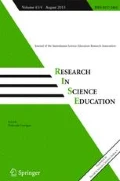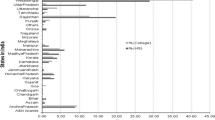Abstract
In 1990/91, a research study was undertaken in England on the Factors Affecting Schools’ Success in Producing Engineers and Scientists (FASSIPES). This study was conducted by Brian Woolnough at the Oxford University Department of Educational Studies, in conjunction with the Institute of Physics and the Institution of Electrical Engineers and National Power (Woolnough, 1991, 1994; Woolnough et al., 1997). Principally, Woolnough attempted to ascertain why young people chose to pursue a career in the physical sciences and engineering. In addition, characteristics of schools which appeared to influence students to pursue a study of science were investigated. A number of countries have since replicated this study as an international research cooperative and the National Key Centre for School Science and Mathematics, Curtin University of Technology, Perth, Western Australia participated on behalf of Australia. Currently, the following countries have contributed to FASSIPES International in addition to England and Australia: Canada, China, Japan and Portugal.
Similar content being viewed by others
References
Breen, D. T. (1989). Enhancing student aspirations: A goal for comprehensive developmental guidance programs.Research in Rural Education, 6(2), 35–38.
Cobb, R. A., McIntire, W. G., & Pratt, P. A. (1989). Vocational and educational aspirations of high school students: A problem for rural America.Research in Rural Education, 6(2), 11–16.
Dawkins, J. S., & Kerin, J. C. (1989).A fair go: The federal government’s strategy for rural and education training. Canberra: Australian Governement Publishing Service.
Department of Primary Industries and Energy. (1988).Education in rural Australia: A discussion paper prepared for the rural and allied industries council. Canberra: Australian Government Publishing Service.
Department of Primary Industries and Energy. (1991).Rural, remote and metropolitan regions classification. Canberra: Australian Government Publishing Service.
Easton, S. E., & Ellerbruch L. W. (1985).Update on the citizenship and social studies achievement of rural 13-year-olds. Bozeman: Montana State University. (ERIC Document Reproduction Service No. ED 262 946).
Edington, E. D., & Martellaro, H. C. (1984).Variables affecting academic achievement in New Mexico schools. Las Cruces: New Mexico Center for Rural Education. (ERIC Document Reproduction Service No. ED 271 267).
Goldstein, H. (1991). Nonlinear multilevel models, with an application to discrete response data.Biometrica, 78, 45–51.
Goldstein, H. (1995).Multilevel statistical models. London: Edward Arnold.
Haller, E. J., & Virkler, S. J. (1993). Another look at rural-nonrural differences in students’ educational aspirations.Journal of Research in Rural Education, 9(3), 170–178.
Hansen T. D., & McIntire, W. G. (1989). Family structure variables as predictors of educational and vocational aspirations of high school seniors.Research in Rural Education, 6(2), 39–49.
Hektner, J. M. (1995). When moving up implies moving out: Rural adolescent conflict in the transition to adulthood.Journal of Research in Rural Education, 11(1), 3–14.
Jöreskog, K., & Sörbom, D. (1993).New features in PRELIS 2. Chicago: Scientific Software International.
Jöreskog, K., & Sörbom, D. (1996).LISREL 8: User’s reference guide. Chicago: Scientific Software International.
McCaul, E. (1989). Approaches to dropout prevention: The philosopher’s stone revisited.Research in Rural Education, 6(2), 25–30.
McCracken, J. D., & Barcinas, J. D. (1991). Differences between rural and urban schools, student characteristics, and student aspirations in Ohio.Journal of Research in Rural Education, 7(2), 29–40.
McGregor, A. L., & Latchem, C. R. (1991).Networks for learning: A review of access and equity in post-compulsory education in rural and remote areas of the State of Western Australia. Perth: Western Australian Office of Higher Education.
Pratt, P. A., & Skaggs, C. T. (1989). First generation college students: Are they at greater risk for attrition than their peers?Research in Rural Education, 6(2), 31–34.
Preble, B., Phillips, P., & McGinley, H. (1989). Maine’s aspirations movement: Reaching out to youth.Research in Rural Education, 6(2), 51–59.
Quaglia, R. (1989). Student aspirations: A critical dimension in effective schools.Research in Rural Education, 6(2), 7–9.
Rasbash, J., & Woodhouse, G. (1995).MLn command reference: Version 1.0. London: Multilevel Models Project, Institute of Education, University of London.
Rasbash, J., & Woodhouse, G. (1996).MLn for Windows: Software for n-level analysis. London: Multilevel Models Project, Institute of Education, University of London.
Reid, J. N. (1989). The rural economy and rural youth: Challenges for the future.Research in Rural Education, 6(2), 17–23.
Rowe, K. J. (1996).Multilevel modelling with MLn: An integrated course. Melbourne: Centre for Applied Educational Research, University of Melbourne.
Sherwood, R. A. (1989). A conceptual framework for the study of aspirations.Research in Rural Education, 6(2), 61–66.
Stevens, K. (1995). Vocational choice for senior high school students in rural Australian communities.Journal of Research in Rural Education, 11(3), 182–186.
Stevens, K., & Mason, D. (1992). Making career choices in rural Western Australia. In C. Boylan (Ed.),Rural education: In pursuit of excellence. Proceedings of the Eighth Annual Conference of the Society for the Provision of Education in Rural Australia. University of New England, Armidale, July 1992.
Strauss, A., & Corbin, J. (1990).Basics of qualitative research. London: Sage.
Strauss, A., & Corbin, J. (1994). Grounded theory methodology. In N. K. Denzin & Y. S. Lincoln (Eds.),Handbook of qualitative research. (pp.). Thousand Oaks, CA: Sage Publications.
Stringfield, S., & Teddlie, C. (1991). School, classroom and student level indicators of rural school effectiveness.Journal of Research in Rural Education, 7(3), 15–28.
Walberg, H. J. (1989). Student aspirations: National and international perspectives.Research in Rural Education, 6(2), 1–6.
Woolnough, B. (1991).The making of engineers and scientists: Factors affecting schools success in producing engineers and scientists. Oxford: Oxford University Department of Educational Studies.
Woolnough, B. (1994). Factor’s affecting students’ choice of science and engineering.International Journal of Science Education, 16(6), 659–676.
Woolnough, B. E., Guo, Y., Leite, M. S., de Salmeida, M. J., Ryu, T., Wang, Z., & Young, D. J. (1997). Factors affecting student choice of career in science and engineering: Parallel studies in Australia, Canada, China, England, Japan and Portugal.Research in Science and Technological Education, 15(1), 105–121.
Young, D. J. (1996, November).The effect of the classroom environment on carrer choice: A rural perspective. Paper presented to the Joint Annual Conference of the Australian Association for Research in Education and Educational Research Association, Singapore.
Young, D. J. (1997, January).Western Australian school effectiveness study: Features of effective schools. Paper presented to the International Congress for School Effectiveness and School Improvement, Memphis, Tennessee.
Author information
Authors and Affiliations
Corresponding author
Rights and permissions
About this article
Cite this article
Young, D.J., Fraser, B.J. & Woolnough, B.E. Factors affecting student career choice in science: An Australian study of rural and urban schools. Research in Science Education 27, 195–214 (1997). https://doi.org/10.1007/BF02461316
Issue Date:
DOI: https://doi.org/10.1007/BF02461316




